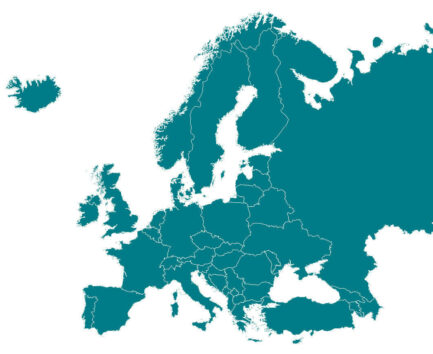Sustainable protein innovation priorities
Explore the results of our market research to uncover commercial white spaces, research gaps, technological needs, and investment priorities at each stage of the plant-based, cultivated meat and fermentation value chain.

Why advance sustainable proteins in Europe?

Sustainable proteins – spanningplant-based,cultivatedandfermentation-made meat, eggs, dairy and seafood – are on the rise across Europe and consumers are hungry for more.
In 2019, Europe accounted for39% of the global market revenueof plant-based meat. In 2020, plant-based retail sales across the continent hit €3.6 billion and European sustainable protein companies raised a record€441 million in investments, making up almost 17% of the total amount invested in the sector worldwide.
Home to much of the world’s scientific and commercial talent, Europe has a unique opportunity to play a leading role in plant-based and cultivated meat – and a transition to a more sustainable food system is essential to achieving the goals of the European Green Deal. But as with any emerging industry, the sustainable protein sector needs to be strategic to maximise its impact.
Introducing our market research work

In order to accelerate the sustainable proteins market as quickly and efficiently as possible, the Good Food Institute Europe conducted a market research study to identify the most pressing challenges across the industry in Europe.
Over three months in 2021, ourcorporate engagement teamconducted 26 interviews with experts in plant-based, cultivated and fermentation-made proteins to discuss existing challenges and future bottlenecks. Our interviews with investors, entrepreneurs, scientists, ingredient suppliers, food manufacturers and more gave us a robust understanding of the current situation across the value chain.
As a nonprofit, we value sharing knowledge freely and generating open-access information that will benefit every innovator in this space. These resources will enable you to find concrete opportunities to get involved with – and accelerate – the vital transformation of our food system. As you’ll see, there are many ways to contribute to feeding our growing population in a secure, sustainable and just way.
Key themes
In addition to the specific challenges and bottlenecks identified, a number of overarching themes were raised that impact the whole value chain.
The most frequent topic raised was Europe’s complexregulatory process. GFI Europe’s policy team is working to ensure there is a robust, fair andevidence-based path to market, so that plant-based and cultivated meat can fulfil their potential to create a more sustainable, secure and just food system.
Another common theme was the need for more productivecollaborationacross the value chain. While there will always be a need for some privacy to protect competitive advantage and intellectual property, sustainable protein companies, suppliers, and ecosystem members can and should work together to create win-win outcomes.
Finally, as the sector grows, increasing consumers’ access to plant-based and cultivated meat, it is imperative to facilitate ajust transitiontowards a more sustainable food system thatbrings existing agricultural communities alongand unlocks new opportunities for them.
How we segment the sustainable protein value chain
We map innovation priority areas and solutions to specific segments within the sustainable protein value chain. Based on your background and interests, click on the segment of the value chain you are interested in learning more about and deep-dive into the key takeaways.

Innovation priorities
Investment
European companies raised€441 million in 2020– more than four times what was raised in 2019, and 17% of the total invested in sustainable proteins worldwide. Although this demonstrates promising growth, the more risk-averse culture of European investors has at times made it challenging for European startups to find funding.
随着行业规模继BOB体育app平台下载续,它将成为increasingly critical to generate investment from sources that have the ability to deploy significant amounts of capital midstream and upstream in the supply chain, or from sources willing to provide opportunities to utilise non-traditional financial instruments, such as venture debt.
Investment priorities
Providing infrastructure capital
As many startups begin to scale up their production, significant investment is needed to finance high capital expenditures.
While venture capital has been instrumental in accelerating the sector to date, the venture capital model is not suited to large infrastructure projects, such as building processing or manufacturing plants. Furthermore, continued venture capital investment dilutes startups.
The industry therefore needs more debt financing to fund the next stage of growth. The creation of infrastructure loan and leasing funds will help supply to keep up with demand and unlock additional economies of scale.
Driving investment into the B2B space
B2B companies in the sustainable protein sector find it more difficult to find funding as investors tend to favour consumer-facing companies. However, the success of B2B companies is crucial for accelerating innovation throughout the whole sector.
For example, companies likeMotif FoodWorks, who have developed myoglobin, a heme-binding protein, will enable plant-based meat manufacturers to develop better products that replicate the flavour and aroma of conventional meat.
Attracting new investors
Educating the investment community
Many investors are eager to get involved with the sustainable protein space but may be hindered by information gaps. Investors beyond those who are intimately familiar with cultivated meat and fermentation approaches may find it time-consuming to learn where to invest due to the dense competitive landscape, limited public information about the technological state of the art, and deep scientific knowledge required to conduct due diligence on startups.
Investors specialising in sustainable proteins should educate the broader investment community through coalitions, syndicated deals, and co-investments with industry-agnostic investors, and spearhead efforts to facilitate later-stage funding like debt and inventory financing.
Research and development
Europe is home to much of the world’s scientific talent, in part due to the European Union’s focus on research and innovation through funding programmes such as Horizon Europe. Horizon Europe will provide €95.5 billion in funding between 2020 and 2027 to tackle climate change, help achieve the UN’s Sustainable Development Goals, and boost the EU’s competitiveness and growth.
While the food R&D industry has historically focused on incremental improvement, the emerging sustainable protein market requires creative and groundbreaking innovation. Visit ourpublic research fundingpage to learn more about how GFI Europe works to secure more government funding for plant-based and cultivated meat research.
Scientific priorities
Developing species-specific research toolkits for cultivated meat
For model species like humans and mice, a vast array of academic and commercial research tools have been developed that enable researchers to easily manipulate, characterise and screen cells, and to probe their behaviour.
For meat and seafood-relevant species, very few of these tools – such as genetic constructs, antibodies, and sequencing probes – have been developed, creating a huge barrier to entry for researchers wishing to work with cells of these species.
Coordinated efforts to develop standardised, comprehensive research toolkits of these species would exponentially accelerate cultivated meat and seafood research.
Identifying new host strains for fermentation
Identifying the best protein strain for fermentation-made products can be a time consuming and expensive process. Each strain offers its own functionality in flavour, efficiency, cost, and nutrition.
一个系统的、对公众开放的、全面的分析of novel microbial strains could drastically expand the available strains that can compete on flavour, efficiency, cost, and nutrition.
Education and training
Building a skilled workforce
The plant-based, cultivated meat and fermentation industries have a significant need for workers and innovators with specialised knowledge spanning multiple traditional disciplines. However, since few universities offer sustainable protein degrees or dedicated subject matter, most relevant knowledge has to be learned on the job.
The industry needs educational programming that can cover the depth and complexity of knowledge, experience and skills required within the context of traditional academic institutions as well as post-graduate professional development and training opportunities.
These programmes could also expand the R&D talent pipeline from scientific communities – cell biology, stem cell biology, biopolymers, materials science, 3D bioprinting – as well as biotech, biopharma, and established agrifood and meat companies.
Training and reskilling people to work in sustainable proteins will streamline the labour transition needed to scale the industry. The need for training and education will also support the creation of new businesses and institutes, facilitating market competition and scientific collaboration that will help generate industry-advancing products, services, and ideas.
Collaboration
Catalysing academic-industry collaboration
Academic-industry collaborations are essential for advancing sustainable proteins because they help build robust talent pipelines, create clear commercialisation pathways for academic research, and drive alignment on priority research questions, challenges and potential solutions.
However, challenges navigating ownership of the intellectual property generated through such partnerships has led to a lack of collaboration. To encourage greater collaboration, the sector needs to build better, standardised frameworks and platforms for coordinating connection and partnership across academic and industry stakeholders.
Fostering R&D partnerships
Collaboration within the industry among different value chain players has been challenging due to intellectual property concerns. However, with new and innovative inputs (proteins, fats, flavours, growth factors, cell media, etc) constantly entering the market, there is an opportunity for suppliers and manufacturers to work together more holistically to optimise product formulation and the compatibility of various inputs.
Knowledge sharing and collaboration like this would benefit the entire industry by reducing duplication of efforts within individual companies, pooling resources, and fuelling innovation.
Raw materials, ingredients and inputs
In Europe today, the main agricultural crops are cereals (wheat and barley) and oilseeds (rapeseed and sunflower). However, this will change over time as the amount of land dedicated to protein crops isprojected to increase 37%by 2030 to meet the strong demand for more plant protein crops.
This will likely lead to larger volumes of the protein crops grown in Europe, such as field peas, broad and field beans, and lupines – which will help supply the European plant-based sector with more local and diverse proteins.
Meeting demand for sustainable protein ingredients
预测对原材料的需求,成分and inputs
Demand for raw materials, ingredients and inputs is outpacing supply, even for the most widely available plant-based proteins like soy and wheat. However, ingredient suppliers are hesitant to increase supply as it is difficult to predict what demand will look like in the short- and long-term.
Publicly available demand forecasts for novel and existing raw materials, ingredients and inputs would address these key knowledge gaps. These forecasts would be particularly valuable if segmented by product type, region, and consumer demographics. Scenario analyses, influence diagrams, and Monte Carlo calculations would enable more effective second- and nth-order estimates about what will be required from upstream suppliers in the value chain. They would also inform technical, regulatory and consumer demand milestones.
Scaling up infrastructure for local, non-GMO and novel crops, and cultivated meat inputs
As the industry continues to mature and food manufacturers and startups seek to meet evolving consumer expectations, there is increasing demand for novel, non-GMO, and local ingredients. However, it can be challenging to establish the agricultural infrastructure – from seeds and farm equipment to storage and transportation – necessary to scale novel inputs efficiently and effectively.
Additionally, in the cultivated meat industry, inputs (such as media and growth factors) are currently being used in small quantities, but there will be a significant uptick in demand for these inputs as the market scales, posing potential supply chain and cost issues.
To motivate farmers to switch to novel species or cultivars and to de-risk their first few seasons, governments should provide insurance or price guarantees, and tailored technical assistance programmes to ensure that sustainable protein inputs can be a profitable and competitive option for growers.
Encouraging co-product valorization
Companies can de-risk operations by exploring either the valorization of side streams from their own processes, or sourcing these secondary materials from external suppliers.
Uses for traditional crop side streams (like husks) or processing fractions (like leftovers from protein isolate extraction) have been identified in some cases – but as demand rises for novel protein sources, finding efficient and valuable ways to commercialise all plant products and byproducts is a major opportunity.
For cultivated meat and fermentation, the challenge is finding ways to recycle or upcycle spent media – the most significant waste product in terms of volume.
Some fermentation companies are also utilising industrial food waste as an input to create a circular process, although this comes with additional regulatory implications to navigate.
Optimising ingredients
Establishing ingredient standards
Ingredients from different suppliers exhibit a range of sensory and functional characteristics, leading to undesired variability in end product formulation. Plant-based meat manufacturers would benefit from raw materials processors and farmers working in concert to develop high-quality, homogenous ingredients.
Better analytical tools for predicting plant-based ingredient performance could also improve manufacturing efficiency and create more transparent ingredient markets. Tools are needed to predict how ingredients will perform in final product applications like plant-based meat and dairy and under various processing methods. Companies could commercialise these tools themselves (in the form of assay kits or analytical equipment) or provide ingredient characterisation as a service.
Driving down costs and optimising cultivated meat inputs
Existing media and growth factor supply chains have largely been developed for the price-inelastic biotech and biopharma industries. Thus, they are too expensive, at too small a scale, and manufactured under certification regimes inappropriate for cultivated meat production.
Research on how to effectively recycle or reuse inputs, such as growth factors, at a low cost and on a larger scale, would help drive down costs.
Processing
Innovating ingredient processing
There is a need for greater exploration of processing innovations, including cheaper methods of protein extraction that can be done efficiently at smaller scales. Ingredient companies today are looking into more efficient deoiling methods, enhancing protein concentrate offerings, and more.
Beyond traditional chemical or mechanical processing methods, ingredients companies and academics should further explore enzymatic and biological processing for sustainable protein purposes.
Production
食品和饮料行业是欧洲最大的马BOB体育app平台下载nufacturing sector, generating€266 billion of value-addto the economy and employing 4.82 million people in 2020.
The plant-based sector in the EU and UK is set togrow to €7.5 billion by 2025– creating huge potential for additional jobs and economic growth. The cultivated meat sector has the potential to add16,500 jobs and £2.1 billion to the economy by 2030in the UK alone.
Technology
Optimising processing techniques
There is a significant opportunity to improve, optimise and innovate on current processing techniques for plant-based, cultivated and fermentation products.
Specifically for plant-based, there is an opportunity for equipment companies and researchers to optimise extrusion for plant-based production, as well as to look into novel methods for texturising and structuring plant-based proteins, such asshear cell, 3D printing, and electrospinning. These innovations will help to improve the taste and texture of end products.
优化培养肉类生产过程BOB体育投注网址for scale
Given the nascent stage of the cultivated meat industry, no company has yet successfully scaled production to industrial levels, so there remains uncertainty around how cells will behave at scale.
In March 2021, independent researchers CE Delft released the firsttechno-economic assessment of cultivated meatto be based on industry data. The development of additional techno-economic models that reflect the latest data provided by companies will be essential to reflect growing expertise and experience, and to guide future process improvements.
Infrastructure
Increasing available, suitable infrastructure
Currently, there is not enough sustainable protein manufacturing capacity, from pilot to demonstration to full-scale, to meet demand.
To meet market expectations for plant-based, cultivated and fermentation products, vast amounts of additional infrastructure will need to be built and existing infrastructure, such as from meat or biopharma, may have to be repurposed.
Facilitating production partnerships
Finding production partners can be a complex and time-consuming process for food startups and organisations to navigate on their own, whether they are looking for co-manufacturing space or a production partner.
Resources and services that make it easier to locate, filter and prioritise partnership efforts would make this easier for startups and add value to existing companies looking for new partners, customers and trends.
End products
With a population of over 740 million people spread across 44 countries, Europe has many different cultures, dietary habits and culinary traditions. This is a unique challenge for sustainable protein companies, as they must adapt their product development and marketing to cater to regional nuances.
Product development
Perfecting tasty, craveable products
The success of the sustainable protein industry rests upon the ability to create tasty, craveable products with identical or superior flavours and textures to conventionally produced meat, egg and dairy products.
While we’ve seen significant improvements, few sustainable protein products have achieved this to date.A recent study across the US and Europeshowed that only 30% of respondents agreed that plant-based meat tasted as good or better than animal-based meat.
As taste is critical to consumer’s trial and acceptance of these products, companies must invest in additional R&D to perfect these products, and governments must fund open-access R&D.
Making sustainable proteins more affordable
A recent study in the UKshowed that four out of every five plant-based products cost more than their animal-based alternatives. This price difference remains a barrier for consumers to try and continue buying these offerings.
This will be especially relevant in the cultivated meat industry, where costs are currently a barrier to commercialisation – butresearch by CE Delftdemonstrates that, with the right investment in innovation and infrastructure, cultivated meat could be cost-competitive by 2030.
Marketing
Demonstrating nutritional advantages
Demonstrating nutrition equivalence or advantage over animal counterparts will help win over European consumers. European consumers have increasingly high standards for the nutrition and clean label of these products – something companies must keep in mind as they perfect the taste and texture of plant-based and cultivated meat.
There are many approaches these companies can take, such as prioritising a clean label, sourcing local and non-GMO ingredients, and matching or exceeding the nutritional properties of conventionally produced animal products.
Introducing consumers to cultivated meat
Demonstrating sustainability advantages
It will be incumbent upon companies to demonstrate the environmental benefits of cultivated meat.
Conducting rigorous life cycle assessments will be critical. These analyses should note the potential for increased efficiencies across all stages of the plant, fermentation, and cellular agriculture life cycles, as well as the opportunities for increased efficiency that come with scaling up production.
It will be crucial to continue these sustainability studies as the industry reaches commercial scale to capture the full effect of this shift.
Educating consumers on cultivated meat
The majority of today’s consumers are unfamiliar with cultivated meat, so companies will need to educate consumers on what their products are and earn brand loyalty in creative ways.
One example is branding their products with a European country of origin, leaning into Europeans’ proud food culture around local sourcing and identity.
Distribution channels
欧洲大陆是由44个国家,each with their own language and food culture. This presents a unique challenge for sustainable protein companies expanding throughout Europe, as it requires a significantly larger distribution network and the adaptation of branding and packaging strategies for each market.
Partnerships
Making connections
Distribution can often be a complex space for young brands to navigate, with a lack of publicly available knowledge about how to approach distribution strategy.
Having more informational resources and matching mechanisms to connect plant-based and cultivated meat companies with the brokers, consultants, distributors, import/export service providers, and other intermediaries would help companies to bring products to market more quickly and profitably, and increase consumer accessibility.

About the author
Carlotte Lucas leads our corporate engagement work, connecting with companies and investors across Europe to encourage investment and innovation in sustainable proteins.








